I have seriously missed blogging! I’m sorry for my consistent absence lately, but all free time is being poured into my book. Yay! The past couple weeks I have been working on background brainstorming for my characters and I needed some serious picture book bedroom inspiration. I filled Pinterest with some ideas, both illustrated and real, and then I realized… this is an excellent thing to post about. It gets the jumbled thoughts and observations from my head into written form and serves for a fun research project. This is in no way exhaustive, (though reading this post will be!) but simply includes every book I currently have on hand that I could immediately think of a bedroom that I liked for some reason or another. So here we go: great illustrated picture book bedrooms!
Kenny’s minimalist room, 1956

This is one of the first picture books that came to mind when I was thinking about bedrooms, simply because Sendak’s illustrations are so spare and striking. This bedroom is really just a cool bed and a window. It leaves so much space for the imaginative story woven around Kenny’s window. Any other details would get in the way.

Eloise’s posh NYC bedroom, 1955

What little girl doesn’t just delight in this room? To be honest, living in our tiny NYC apartment — I’m drooling over the sheer size of this room! And those built-ins? And the view peeking through the window? Hilary Knight is truly a fantastic illustrator. I love the minimal color in the room, an obvious fit for the book, but also incredibly brilliant design to keep such a busy room still looking inviting. There are so many details in this one illustration that give you info about the heroine herself — the pink scribbles on the wall, the lack of organization, the ONE chair at the tea table, the ladder propped against the wall…. Such thoughtful placement and insight to add depth to the character.
And let’s not forget Weenie’s wee bed:
A surprisingly skinny pug, made all the more surprising considering this illustration tells you how spoiled he must be.
Adorable room with a secret under the bed, 1966
This is one of my favorite Whitman Tiny Tot Tales and my girls have adored it too. There’s just something about this little room with the turtle hiding in a hat box under the bed that is such a vintage and yet somehow timeless room. The imperfect wallpaper on the wall adds a great tying element; so much so, that one almost doesn’t notice the missing floor line on the far left wall. Ha! The furniture is very mid-century in design. The toys in the toybox are stereotypical, generic, and delightful. The flowerpot on the window always makes me smile too.
The color palette is charming. Blues, browns, yellows, and black line keep it looking full, but not too colorful. It definitely has a stereotypical vintage boy vibe to it, which matches the protagonist; but it could quite wonderfully work for either with its lovely feminine touches of floral inlays and the flowerpot too.
And let’s talk about that rug. I have noticed an odd trend in picture book illustration for there to be an oval rug, usually with inner rings. I’m still pondering whether this is a purposeful choice because of the era intended, or if it was chosen for its specific geometric balance. Keep a look out for oval rugs in picture books. You’ll be surprised at how many begin to appear for you.
The artist bed, 1976

This scene could also be called “the bedroom of my dreams.” Green, books, painting… there’s very little that I could add for my own sleeping arrangement goals. I love this particular bedroom scene because the layout is extremely purposeful and well-thought out. The side table and headboard serve as a border for two sides, drawing the eye to the vast blank space on the white pillow and bedspread. This leads you to focus on the girl painting intensely, lost in her imagination. The stroke she is working on has already moved past the edge of the paper, breaking one border and you’ll notice there are no other borders in sight for where the next strokes, and her imagination, can go. It is beautiful.
Also notice the color palette: limited mainly to green and orange which are opposites on the color wheel and the green is used as a grounding, comforting color; with the orange popping in for excitement, interest, and matching the bold personality of the little girl.
Bed as the best playground-type prop, 1960

Sendak has a lot of memorable bedrooms — from Where the Wild Things Are iconic bedroom turned jungle scene; to Kenny’s Window mentioned earlier; Bears, Bears, Bears comes to mind too; and even in this short vignette from a brilliant Ruth Krauss book. I’m drawn to the style of this bed, but I particularly love the way it is used for the child’s imagination. Substitute a treehouse or playhouse for the bed, and the boy’s stance and dog’s lookout point still work excellently. A bed is not just for sleeping in Sendak’s and Krauss’ minds.
Also, I love the boat picture hanging above the bed and the way it combines with the imagined boat the boy is calling boarders too. And that light on the headboard… cracks me up for some reason. I don’t know that I’ve ever seen one in a kid bedroom, but why not?
Flat, full room for encyclopedia-like purposes, 1985
The perspective of this illustration is marvelously simple in a picture book perfection kind of way. I admired this bedroom because of all the “nice things” it is filled with. Wonderful toys, bookcase, a fun headboard inlay, and a polka dot chair… everything is so delightfully quirky and feels realistic thanks to the ajar closet door and even the sock hanging out of the dresser. This page always makes me think of playing with paper dolls and this being a room that I want to make the dolls go in and explore. Rockwell’s color palette is very bold and, while I don’t find a lot of direction about where to rest my eyes or a solid focal point, the goal of this book is to be seek-and-find.
Imogene’s chaotic bedroom, 1985

A favorite book from childhood, this bedroom—though not very visible in whole—is a great backdrop to Imogene’s distressing story. It is a full background, but quite flat in dimension and even in color, so nothing is too distracting. Imogene’s face and shock are front and center. Her bedroom is one of those that is there for the sole purpose of coming back to it on rereads. As I child, I would study her toys and that dollhouse (oh! that dollhouse), delighting in imagining playing with those things.
I do find the black shoes on her bed both disturbing (gross shoes on the bed!) and a little oddly placed in dominant color. But the really fantastic detail for me is the dormer windows of her dollhouse serving as eyes staring at her in her predicament. Absolutely brilliant.
Extra-long bed for a plant-loving pet, 1958
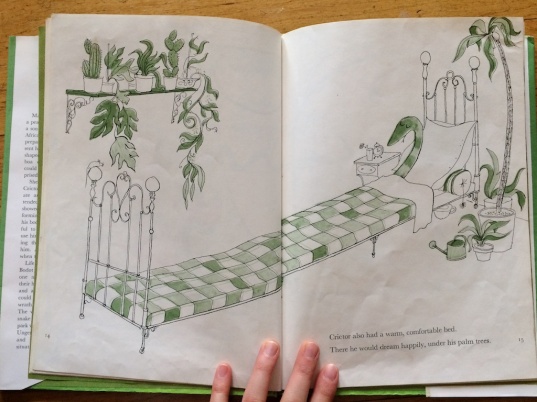
I love this book so much. Not only is it by Tomi Ungerer, hilarious, and clever; but it has two colors: black and green. Who could want for more? Crictor’s bed is delightful with his extra-long, comfortable bed and his decor of greenery. The layout of the page is excellent and I adore the thoughtful placement of all those plants, the tiny side table and its elements, the tube pillow with the spider coming out, and even the odd teacup underneath his bed which I’ve never quite understood. Ungerer never ceases to delight me with his linework, details, and humor.
The clue-filled bedroom of an extremely clever teacher, 1977
One of the few picture books that successfully features an adult protagonist, I equally adored and was terrified by this book as a child. The image of Miss Nelson’s bedroom will never leave my memory as it is not just an illustration of her bedroom; but also the answer to the mystery of the book. You have to “read” this illustration, which is so empowering as a child, because the text never tells you what secret is there.
I love how cramped the bedroom is and the many details that add to the character of Miss Nelson. But the real key to this bedroom is that it tells the story too. Using the background as a character is quite clever and I would love to know how that was decided between author and illustrator.
Owl’s less-than-peaceful bedroom, 2016

This book is on my review list and has been since it came out. We LOVE this book. As we do everything Greg Pizzoli does with his picture books. But here, let’s just look at Owl’s bedroom. Greg puts a lot of secrets (or “Easter eggs”) into his backgrounds, something my children (and myself) positively adore. In Owl’s bedroom, there is a portrait of a crocodile, that famous one from Greg’s first picture book The Watermelon Seed. Owl also must be quite a celebratory fellow as he has a decorative banner up over his bed. His side tables, I believe, are mid-century in style, fitting for the rest of Owl’s home in the book, and are minimal in size and content. The quilt on Owl’s bed is an interesting melding of the color palette and helps with its busyness to frame Owl’s face as the focal point. And yes! Note another oval, ringed rug peeking in from the right. They are everywhere in picture books!
I particularly chose this bedroom because I love the perspective shown; the symmetry that balances the scene, but isn’t boring; and how the color palette is surprising in its tonality, but works so effectively.
Reggie’s architecturally interesting sleepover room, 1972

Another beloved favorite from my childhood, Reggie’s room always comes back to me when I’m thinking about picture book bedrooms. I adored this book as a kid, partly because I never had or went to a sleepover when I was a kid. The concept was so interesting to me. I also loved this book because I was very into stuffed bedtime friends myself and totally understood Ira (and Reggie’s) concerns about them.
But let’s look at the room. This is still one of my favorites in this bunch. First off, the architecture of the room is incredibly interesting. I always wish I could see the house and understand the layout. Reggie’s room must be the attic to have the pointed beam at the top, the angled walls, and the small window. The wood floors are a lovely touch (and it strikes me as interesting that they are horizontal, not particularly drawing the eye to them; and Owl’s bedroom floor is vertical floorboards, drawing your eye upwards.) I also love Reggie’s bed and that trundle was a childhood dream of mine. The floral rug on the floor is such an interesting, dare I say, odd afterthought of a decor decision. The coat rack cracks me up, mainly because I’ve never seen a coat rack in a kid’s room before. And I have always wondered about the “Stop” sign on the wall. I wonder if Waber planned the room for specific reasons or if it was mimicking a room he liked or knew himself.
Henrietta’s shared, delightful room, 2008

Perhaps it is because I am now a parent and constantly trying to figure out the best solution for two kids in a small NYC bedroom; but I am so intrigued by this room. I honestly didn’t remember it until I was scouring my bookshelves, thinking about which bedrooms existed between the pages and I spied this book and seemed to recall a bedroom scene. I’m so glad I did, because this bedroom will now stay with my memory.
This book is hilarious and adorable, and the bedroom itself speaks to the clever humor and illustration style of Delphine Durand. That loft bed alone has my older daughter drooling with envy and my mama heart beating fast about that tiny metal ladder. Ha! I love the cohesiveness to the room, but the distinct styles of the sleeping arrangements. Henrietta is the left-out one of the three siblings and even the placement of her bed speaks to that fact. The book’s gutter almost acts as that invisible line dividing the two older girls’ space with Henrietta’s. The carpet is bold and dark, with a neutral rug on top (not oval or ringed, which feels much more modern.) I love all the dolls, animals, and monsters sprinkled around – adding character and filling the spaces with warmth. And Delphine’s pattern use is excellent. Not too much, and not too similar patterns; but just enough to keep you interested in the space.
Dave & Bella’s little bedroom, 1977
Another shared sibling space, this one is much more cozy and intimate. There are two, rather large beds for the kids and I love how things are strewn about the floor showing the life lived in the room. Bella’s side of the room has a few pictures on the wall, the only distinguishable one being of three bears. And the best part is Bella asleep in her bed, barely fitting in the large bed because of all her teddies who join her at night.
Hughes also uses wood floors, these at an interesting almost vertical, but slightly tilted angle. And there is a tiny, fringed rug between the beds. This is a cozy home with loving siblings.
Jasper’s room of nightmares, 2012
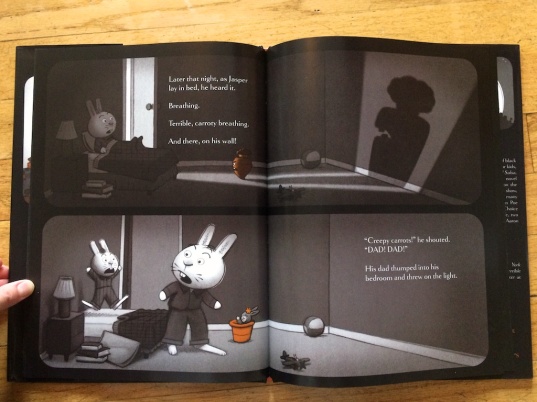
I had to place this book next in the line-up because these two rooms are just so incredibly opposite in feel. Where Dave & Bella’s room was cozy and intimate, Jasper’s room is dark, empty, and, of course, creepy. Perhaps they just moved in, perhaps Jasper likes great open spaces to play, or perhaps the carrots are creepier than we feared and they moved all of Jasper’s stuff to one side of the room for full shadow effect. We may never know, but Jasper’s room exists for the sole purpose of scaring him to death every night when he is trying to fall asleep. His bed, table, lamp, and pile of books all sit tightly on one side of the room, leaving just a few objects to be lonely on the other side. This is a great example of a picture book bedroom set to aid the story and not necessarily be loving and livable.
Sadie’s blank canvas of a room, 2015
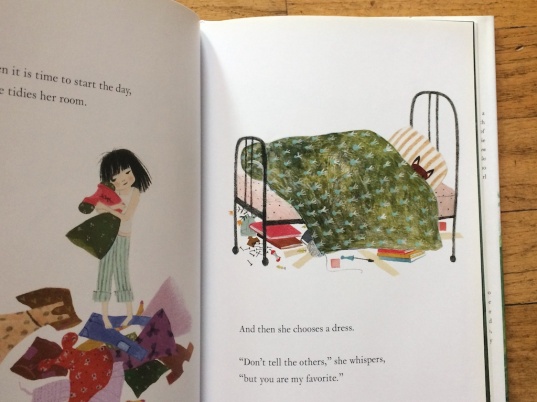
Oh, how we love Sadie. And her room, though sparse with details, immediately came to mind. I was actually surprised when I opened the book to it because in my head, there was much more. But no, Sadie’s room is minimal: just a bed, her supplies, and her imagination. Her stuff is jammed under her bed and into a corner, leaving lots of room for imagining and playing and disappearing into her ideas. Julie Morstad will always be a favorite illustrator for me and she gives lots of fodder for imagination to her characters and her readers. Patterns are key to Julie’s work and somehow she always makes them work together in tone and color palette. I love that Sadie’s fox is barely seen in her bed. And she has books and tools and supplies overflowing beneath her bed.
And I have to include the last scene of her bedroom from the book. Her supplies are either tidied or not visible from the perspective. But that little mushroom light is just the best accessory. Sadie needs nothing more but her imagination. Sweet dreams Sadie girl.
Quaint, colorful sibling room, 1955
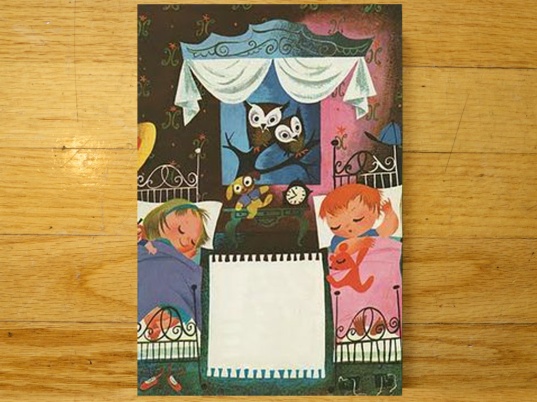
Seems only appropriate to follow a Morstad illustration with a Mary Blair. The two brilliant illustrators could not be pictured more differently than these two bedrooms. Blair’s sibling bedroom is packed full with color, shapes, and cuteness. From the wallpaper to the bed frames, Blair’s eye for detail shines through. It is hard to pinpoint the brilliance in this adorable illustration, there is just so much to look at and smile. Some of my favorite details though are the shoes under the beds, the hats hanging on the knobs of each bed, and the too small blankets that show the sleeping children’s feet! I am also a huge admirer of Blair’s use of pink. She knew how to capture and not fear colorful illustrations.
The inventor’s inspiring bedroom, 1964
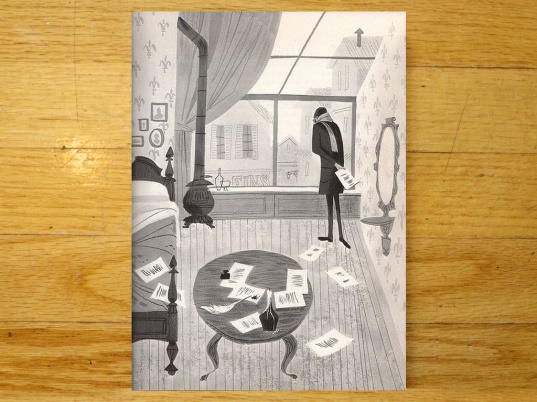
This is one of those illustrations that catches my breath every time I see it, which is made all the more striking by the fact that it is black and white. Plasencia’s use of flattened perspective is absolutely spectacular. The lines, the patterns, the layout… it is all just superb. Some of my favorite details are the bed frame shape, the view out the fantastic window, and the collage of frames on the wall above the bed.
A blue room for a fox lover, 2017
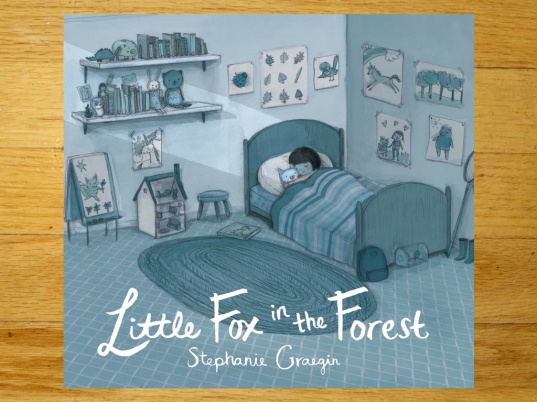
This is my very favorite picture book bedroom in a new picture book. I had heard rumors of this book coming out soon and had it on hold from the library. And then I cheated and couldn’t wait to receive my copy before reading it at Book Culture last week. It is a new wordless book from the fabulous Stephanie Graegin. We are captivated by it. But that is for another post.
Here, I need to analyze and adore the bedroom of this sweet little protagonist. This is the title page from the book. First off, note the oval, ringed rug. Yep. Next, I love all the drawings and paintings on the little girl’s wall. And that dollhouse, the books on the shelf, the butterfly net and boots… so many brilliant details in this room that play a part in the unfolding of the story within. I would love to see the process behind creating this book! The angle of the perspective is also so well done. And I will forever be an admirer of Stephanie’s use of light.
Another blue room of mid-century delights, 1958

A couple quick final images from vintage favorites: here is a bedroom scene from Graboff. I have always loved Graboff’s fearless, bold layouts and characters. There is no cutesy in his illustrations, just bold. The perspective of the bed, the character, and then all the detailed items on the side table are just so excellent, that clock especially.
A happy bedroom, 1965
And one last bed scene that I keep coming back to. I love ink illustrations and I especially adore this one. The background is perfection in ink alone, and then layered on top is the colorful child and that brilliant quilt. And yes, note the oval, ringed rug. You thought I was kidding, didn’t you? I love all the details here from the ironwork on the bed, the decorative open window, the boots, the sweet cat, and even the detail of the pillow inside the pillowcase! So well done.
And lastly, I leave you with one more vintage picture of the oval, ringed rug in Gwen’s house. Keep your eyes out for these mysterious favorite rugs to illustrate.

And now, if you’ve read this far, you must obsess over picture book illustration too. So, I need to know your favorite picture book bedrooms, old or new. Come on, load me up with inspiration!









Such a great post!!! I love the bedrooms in “Jessie Bear, What Will You Wear?” (well, all the rooms in that home!) and the Golden Book, “Little Mommy”. And I 100% concur on the Julie Morstad illustrations – the rainy day bedroom in “Today” is so much fun.
LikeLike
Ooh! I don’t have Jessie Bear. Will be looking that one up ASAP as it has been a while since I’ve read it. I LOVE Bruce Degen illustrations. They make me very nostalgic. I cannot recall the Little Mommy one. I’ll have to sift through our Golden Books and find it. That makes me think of Eloise Wilkins bedrooms too. They made need a post of their own! Ha! I love having a Morstad fan friend too! Thanks for reading!
LikeLike
What a great bunch of stories. I have to admit I have never looked this closely at illustrations.
As far as stories with beds in them – off the top of my head – How about 10 Minutes ‘Til Bedtime by Peggy Rathman. I also love Goodnight Gorilla by her. I love how there are little detail changes (like 1,2, then 3 people watching) over time in her pages. Also, she has a ton of Easter Eggs.
The quilts in the Little House pictures books are so amazing. I often find myself just looking at them – especially the one on Ma and Pa’s bed.
LikeLike
Peggy Rathmann is a great thought! I’ll have to pull those out and look through them again. And my Instagram friend Renee Graef illustrated the Little House picture books. She does amazing detail work!
LikeLike
I’m pretty lukewarm about Berenstain Bear books, but I think the interiors, particularly Brother and Sister’s bunkbed, are pretty memorable. There’s a certain coziness to Papa Bear’s handmade wooden furniture.
LikeLike
Yay the blog is back.
There is also the bedroom of all 12 of the girls in Madeline…that is the ultimate sharing of a room!
And there is the Green Room in Good Night Moon 🙂
LikeLike
This is such a fascinating post! I’d love to hear more about your creative process, and your experience illustrating a picture book. I always think that illustrators deserve so much credit, because they can really make or break a picture book!!
LikeLike
One of my very favorite books as a child was The Fourteen Bears in Summer and Winter. (It was republished a number of years ago in a slightly different size format,but it’s still great.) I pored over the pictures of the different beds/bedrooms each bear had in its tree house. The great question was always, “Which bedroom would I want?” (the one with the bed with the curtains? or the fluffy bed in the room with the quaint painted chairs? certainly not the hard looking bed in the modern room.) If you don’t know this book, run out and get it right now! You’ll love it! I also love every room, including the bedrooms, in Let’s Go Home, illustrated by one of my favorite illustrators, Wendy Anderson Halperin. Check out all the details.
LikeLike
Hi Sarah! Thanks for reading and commenting. Wow! That bear book looks amazing. I don’t remember ever seeing it. It is also extremely collectible. I can’t find it for less than $150, and that is a cheap price apparently! I love a good book challenge though. 🙂 Thanks for sharing. I’ll track it down somehow!
LikeLike
Yikes, $150! I still have my tattered childhood copy, complete with mustaches drawn on the bears and the last page missing. I was so excited when it was republished that I bought copies for myself and my brothers so that we could then share it with our children. (and so I could finally see that last page again-a glorious spread of how each bear decorated his tree for Christmas!) I enjoyed this post so much and hope you get a chance someday to see this.
LikeLike
In “When Bunny Grows Up” sometimes titled “The Bunny Book” by Patsy Scarry-one of the final pages is the Daddy Bunny putting all of the the little bunnies into a giant bunk bed with three or four layers and two bunnies in each. It is one of my favorite illustrations in the world.
Thanks, loved this post!
LikeLike
This post immediately got me thinking of the 2008 picture book “In a Blue Room,” by Jim Averbeck, illustrated by Tricia Tusa. Since the book is about the room…
LikeLike
Good Morning and a good talk on bedrooms in children’s books. On David Small’s book Imogene’s Antlers, the shoes on the bed, patent leather shoes were in the 1950’s Sunday shoes and special day shoes. To clean them was important with Vaseline Jelly and a rag top first then the bottom always kept precious by the child. Otherwise they were Buster Brown shoes for school. Love this article. Bedrooms for me were always designed by my mother and dear grandmother, they changed since we moved often. Rugs in Michigan on the floor kept the child warm and could play on the rug. Old furnaces in the apartment basements were dreadful too much heat or the coal was not delivered on time. Hence the round rugs grandmother tied for us. Thanks again. atk
LikeLike
Gyo Fujikawa’s rooms are always lovely. And Arnold Lobel’s bedrooms, like Frog & Toad or that tucked in alligator.
LikeLike